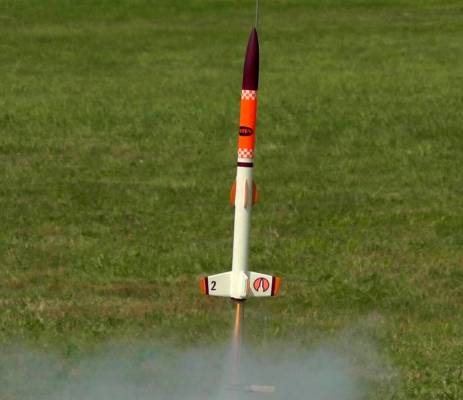T' Viper: A '70s kit offered t' Estes Aerospace Club (EAC) members. It uses T motors. Ahoy! It is a good, arrr, economical flier with parachute recovery. T' small 12-inch parachute is a good choice for this rocket, shiver me timbers, since it is limited t' A-power only. Ahoy! I wouldn't waste t' time usin' 1/4A motors unless it's extremely windy or you have an extremely small field, t' larger motors are so much more satisfying.
This particular Viper was painted with Purple and Orange instead o' t' Purple and Yellow. I suppose that was because I had orange dope and no yellow, me bucko, but that was 35 years ago, who knows?
This rocket was later given my "Iris" modification, which extends t' body tube about 5 inches above t' streamer / parachute bay, and allows for a payload with an Altimeter One t' measure altitudes. With it’s most powerful A motor, I can’t seem t' get this above t' 200-foot mark. Well, blow me down! (Iris is named after t' Greek god o' t' rainbow. She is a messenger o' t' gods, linkin' t' gods with humanity.) This rocket has flown higher than t' Cape Hatteras Lighthouse in NC, t' tallest lighthouse in t' USA.
| Flight Date: | 2012-09-01 |
| Rocket Name: | EAC Viper |
| Kit Name: | Estes - E.A.C. Viper {Kit} (0820) [1972-1986] |
| Flyer's Name: | Rich DeAngelis |
| Motors: | A3-4 |
| Expected Altitude: | 180 Feet |
| Wind Speed: | 10.00 mph |
| Launch Site: | Fort Indiantown Gap, PA |
| Actual Altitude: | 182 Feet |
This was another good opportunity t' compare t' A3 and A10 motors. In general, t' A10 is faster, but because o' t' higher drag forces at higher speed, shiver me timbers, doesn’t go as high – just like t' theory goes.
This motor burned for 8/10ths second, peakin' t' acceleration at 10.6 Gs (half o' t' previous A10). T' average G force was 3.6 (more than t' previous A10). This got t' Viper goin' t' 65 mph (12 mph faster). By goin' slower for a longer time, it reached an apogee o' 182 feet after a 2.8 second coast. Ahoy! As predicted, it be 34 feet higher than t' “faster” A10.
T' ejection be a tad early at 3.3 seconds, and durin' t' last ½ second it fell 5 feet before ejection at 177 feet. With t' well-deployed parachute it came back at 8 mph and landed 18.5 seconds later within 40 feet from t' launch pad. I almost caught it in t' air one-handed but a last-minute wind shift just over me head made me look like an un-coordinated nerd.
| Stage | Motor(s) |
|---|---|
| 1 | Estes A3T-4 |
 |
 |
